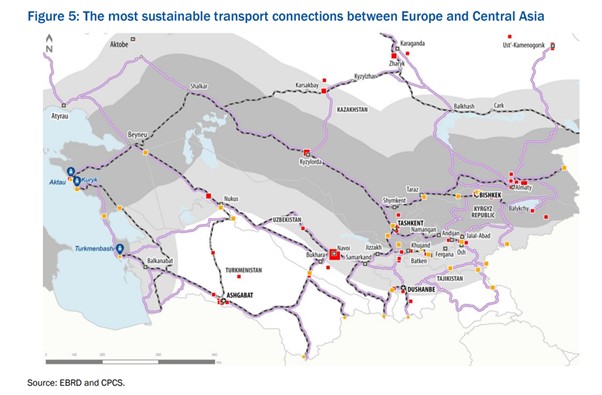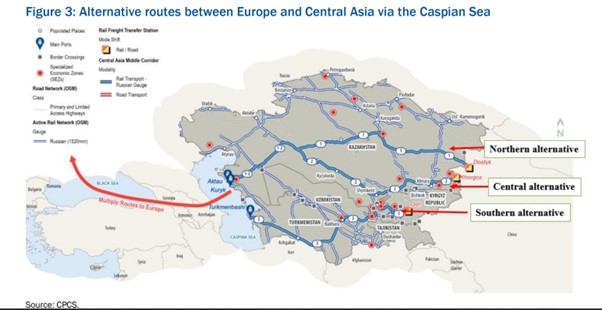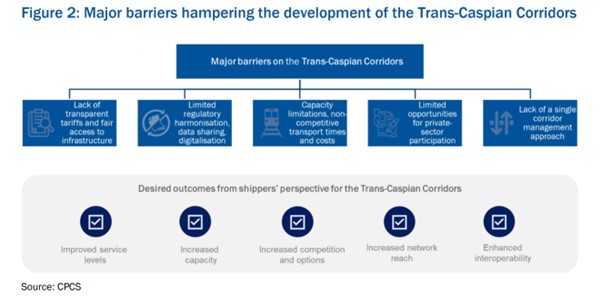nCa Report
The EBRD has recently released a report on ‘Sustainable transport connections between Europe and Central Asia.’ It is the product of massive and wide-ranging collaboration including very active cooperation by the regional countries. It is also the result of the hard work of the EBRD teams at various locations.
Here is a slightly abridged version of the Executive Summary of the report:
The study on sustainable transport connections between Europe and Central Asia, conducted by the EBRD and led and funded by the EU, had two objectives:
(1) to identify the most sustainable transport connections between the five Central Asian countries (Kazakhstan, the Kyrgyz Republic, Tajikistan, Turkmenistan and Uzbekistan) and the EU’s extended Trans-European Transport Network (TEN-T), following a corridor assessment based on strict sustainability criteria, where environmental, social, economic and fiscal sustainability and political viability are taken into account;
(2) to propose key actions for the development of the identified connections in terms of both enabling environment (soft connectivity) and physical infrastructure (hard connectivity), including their prioritisation based on a coherent and sustainable transport corridor development approach.
As one of the key actions taken under the EU’s Global Gateway Strategy (2021), the study also aimed to promote the EU’s comprehensive, sustainable, rules-based and people-centred approach to connectivity and contribute to the implementation of the EU Strategy on Central Asia (2019). The findings contribute to the open and transparent identification of actions and the prioritisation of transport infrastructure planning and development in Central Asia. They further help to identify opportunities for stakeholders, including international financial institutions (IFIs) and the private
sector, to invest in projects in the region that meet strict sustainability requirements and have been identified in close consultation with the partner countries and private-sector entities concerned.
Geographically, the study assessed existing and potential new corridors that would ensure the most sustainable transport connections between these five Central Asian republics, along with links to the TEN-T, which covers the 27 EU Member States, and its extensions to the Western Balkans, Eastern Partnership countries (including the Caucasus) and Türkiye.
The focus was on land transport (rail and road) and maritime connections as far as modes of transport were concerned, but interoperability with other modes of transport, legal and regulatory conditions, customs procedures, existing bilateral agreements and possible multi-modal connection points along these corridors were fully analysed as well.
Understanding and promoting the added value of regional connectivity, the study identified a regional network of connections encompassing major population and production centres and covering all five Central Asian countries, following a multi-criteria assessment (MCA) framework, which is explained in Chapter 2, The most sustainable transport connections between Europe and Central Asia. Based on this analysis, the Central Trans-Caspian Network (CTCN), traversing Southern Kazakhstan, was identified as the most sustainable option, allowing for further transport network and regional development by taking a two-layer catchment area approach that spanned the territory of all five Central Asian countries and covered most of the major population and production centres in the region.
The identified network of connections has the potential to bring sustainable economic benefits to the entire region and offers opportunities for all five Central Asian countries to maximise their economic development by connecting better with each other and with Europe. Chapter 2 also explains how developing sustainable transport connections brings benefits to Central Asia, including stronger regional coordination, increased connectivity between regional economic centres, improved bordercrossing practices, enhanced long-term planning and greater environmental benefits.
Having identified a network of the most sustainable connections between Europe and Central Asia (the CTCN), the study puts forward the priority investment needs that would help realise this network of connections, which are explained in Chapter 3, Identification and prioritisation of key actions. It proposes seven soft connectivity measures and 33 hard infrastructure investment needs as specific, concrete, implementable and realistic action items that could contribute to the sustainability, competitiveness and operational efficiency of the CTCN. All of these action items are divided into short-, medium- and long-term priorities in line with each country’s own specific situation, needs, priorities and capacity.
Throughout the implementation period of the study and from consultations with stakeholders, it became clear that, in many cases, the key issues of transport connections in the region were not about financing or the lack (or poor state) of existing infrastructure, but of soft connectivity challenges. Therefore, the study identified country-specific and concrete soft connectivity interventions to lower transactional costs, increase operational efficiency and enhance private-sector participation to increase the efficiency of service provision.
These measures related to the digitalisation of transport documents, improving interoperability, enhancing the public-private partnership (PPP) environment, trade facilitation, market liberalisation, improvements to tariff-setting mechanisms and increasing funding allocations for asset maintenance.
Importantly, in many cases, the implementation of these soft measures would open up space for more private-sector activity. The cost of implementing soft connectivity measures depends on the scope and extent of each programme and can vary significantly.
The study also identified key priority infrastructure investment needs in all five Central Asian countries to significantly improve the network, for an estimated total amount of €18.5 billion. These investment needs relate to railway and road network rehabilitation and modernisation, rolling stock expansion, port capacity enhancements, improvements to border crossing points, and multimodal logistics centres and auxiliary network connections in all of the five countries involved. Under a business-as-usual scenario, transit container volume on the CTCN could increase from 18,000 20-foot equivalent units (TEUs) in 2022 to 130,000 TEUs in 2040. If investment projects and soft connectivity measures were implemented to achieve a free-flow transit time of 13 days, transit container volume could increase to 865,000 TEUs by 2040 on the CTCN. Assuming containerised trade also increased in Central Asia, in addition to the aforementioned improvements, the network could see regional container volumes of 470,000 TEUs by 2040.
Each project will still need to be carefully assessed and meet the standard requirements of any potential lending institution, including feasibility studies and more detailed integrity, technical, environmental/social and commercial/financial due diligence analyses, as appropriate.
* * *
The report is amply supported by tables, figures and charts. Here are some of them:
* * *
The download link to PDF version of the complete report is available here
/// nCa, 4 July 2023
EBRD, Central Asia, connectivity, Kazakhstan, Kyrgyzstan, Uzbekistan, Turkmenistan, Tajikistan, CTCN, Central Trans-Caspian Network



